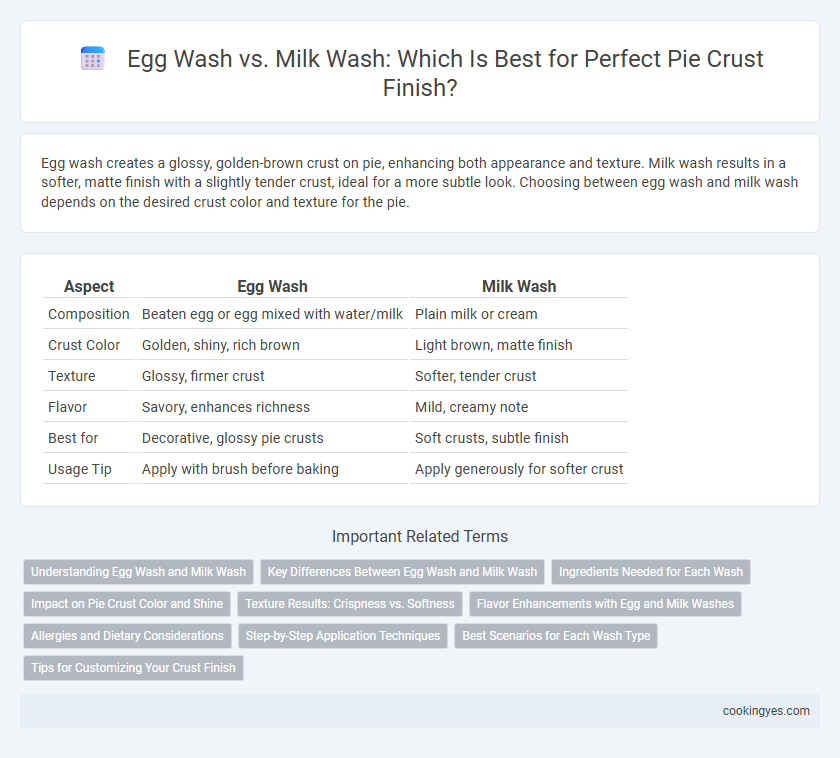Egg wash creates a glossy, golden-brown crust on pie, enhancing both appearance and texture. Milk wash results in a softer, matte finish with a slightly tender crust, ideal for a more subtle look. Choosing between egg wash and milk wash depends on the desired crust color and texture for the pie.
Table of Comparison
| Aspect | Egg Wash | Milk Wash |
|---|---|---|
| Composition | Beaten egg or egg mixed with water/milk | Plain milk or cream |
| Crust Color | Golden, shiny, rich brown | Light brown, matte finish |
| Texture | Glossy, firmer crust | Softer, tender crust |
| Flavor | Savory, enhances richness | Mild, creamy note |
| Best for | Decorative, glossy pie crusts | Soft crusts, subtle finish |
| Usage Tip | Apply with brush before baking | Apply generously for softer crust |
Understanding Egg Wash and Milk Wash
Egg wash, composed of beaten eggs sometimes mixed with water or milk, creates a glossy, golden-brown crust ideal for pies and pastries, enhancing both appearance and texture. Milk wash, typically brushed on with whole or skim milk, produces a softer, less shiny finish while promoting even browning and a tender crust. Choosing between egg wash and milk wash depends on the desired crust finish, with egg wash providing a rich sheen and milk wash offering a subtle, matte appearance.
Key Differences Between Egg Wash and Milk Wash
Egg wash creates a glossy, golden-brown crust with a slightly richer color due to the protein and fat content in eggs, whereas milk wash results in a softer, more matte finish with a subtle browning effect. Egg wash enhances crispiness and shine, making it ideal for decorative pastries, while milk wash provides a tender crust and helps in browning without a strong shine. Both washes influence texture and appearance, but egg wash offers a more pronounced color and gloss compared to the milder, creamier finish of milk wash.
Ingredients Needed for Each Wash
Egg wash requires beaten eggs, often combined with a small amount of water or milk to achieve the desired consistency and sheen on the pie crust. Milk wash involves using plain milk or cream, sometimes lightly brushed to promote a softer, golden-brown finish without the shine of egg wash. Both washes enhance the crust's texture and color but differ in ingredient composition and the resulting aesthetic effect.
Impact on Pie Crust Color and Shine
Egg wash creates a rich, golden-brown crust with a glossy shine due to its protein and fat content reacting to heat. Milk wash results in a softer, matte finish with a lighter color, as lactose promotes gentle browning without the intense glossiness. Choosing egg wash enhances visual appeal and crunch, while milk wash offers subtle warmth and a tender texture.
Texture Results: Crispness vs. Softness
Egg wash creates a glossy, golden crust with enhanced crispness due to its protein content that promotes browning and firmness. Milk wash results in a softer, tender crust by providing moisture and a gentle caramelization effect without the pronounced crunch. Choosing egg wash emphasizes a crisp texture, while milk wash favors a softer, more delicate pie crust finish.
Flavor Enhancements with Egg and Milk Washes
Egg wash enhances pie crusts by adding a rich, glossy finish and a slightly savory flavor that deepens with baking, creating a golden-brown appearance and a subtle umami taste. Milk wash contributes a softer sheen and a milder, creamy sweetness, which accentuates the crust's tenderness without overpowering the pie's filling. Both washes improve crust texture and flavor, with egg wash offering more intensity and milk wash providing delicate richness.
Allergies and Dietary Considerations
Egg wash creates a golden, glossy crust but can trigger allergies for those sensitive to eggs and is unsuitable for vegan diets. Milk wash provides a softer shine and can be a lactose concern for individuals with dairy intolerance. Selecting between egg wash and milk wash depends on balancing desired crust appearance and catering to guests' allergy and dietary restrictions.
Step-by-Step Application Techniques
Applying an egg wash to pie crust requires lightly beating one egg with a tablespoon of water or milk, then brushing it evenly over the dough for a glossy, golden-brown finish. For a milk wash, simply brush cold or warm milk directly onto the crust to achieve a softer, matte finish with subtle browning. Using a soft pastry brush and applying thin, even layers ensures optimal adhesion and prevents sogginess during baking.
Best Scenarios for Each Wash Type
Egg wash creates a glossy, golden-brown crust ideal for savory pies like quiche or meat-filled pastries, enhancing both appearance and texture. Milk wash produces a softer, matte finish that suits fruit pies and delicate crusts, providing subtle browning without overpowering natural flavors. Choosing between egg and milk wash depends on desired crust color, shine, and the type of pie filling being used.
Tips for Customizing Your Crust Finish
Egg wash creates a glossy, golden crust with a slightly richer flavor, ideal for savory and sweet pies wanting a more pronounced shine and color. Milk wash results in a softer, matte finish with a subtle browning effect, perfect for achieving a tender, less glossy crust appearance. To customize your crust finish, experiment by mixing egg wash with a tablespoon of water or milk for a balanced sheen, or brush milk wash lightly on delicate pastries to maintain a gentle crust texture.
Egg wash vs milk wash for crust finish Infographic

 cookingyes.com
cookingyes.com